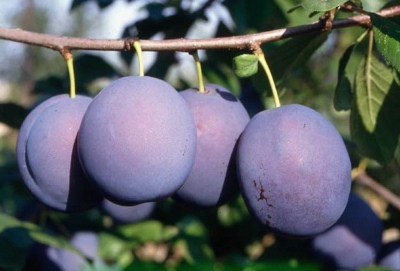
- Authors: USA
- Appeared when crossing: Stanley x President
- Name synonyms: Bluefre, Blue Free
- Growth type: vigorous
- Crown: dense, spreading, broadly oval
- Tree height, m: 2-5
- Fruit size: large or very large
- Fruit weight, g: 60-70 and more
- Fruit shape: rounded oval
- Fruit color: dark bluish, with a dense waxy coating
Bluefri plum - luxurious, with large fruits, is one of the most desirable varieties for Russian gardeners. Since it has not been tested in the Russian Federation, there is no registration in the State Register either. Saplings can also be found on sale under the name Blue Free.
Breeding history
A variety of American selection. It was obtained by crossing the legendary Stanley plum and President.
Description of the variety
Bluefri has a significant growth force. An adult plum tree reaches 5 m in height, a young one quickly stretches by 2 m or more. The crown is formed broadly, it is dense and spreading. Shoots from the central conductor branch off at a significant angle. Fruiting occurs on bouquet branches.
Fruit characteristics
Plums of this variety are highly marketable, have good transportability, and have excellent commercial prospects. The fruits are very large, each weighing 60-70 g. The shape of the plums is round-oval, the skin is dark bluish, with a dense waxy bloom, with pronounced subcutaneous punctures located chaotically. The pulp of an unripe fruit is greenish, yellow when fully ripe. The stone is large, poorly separated.
Taste qualities
Plums are sweet, honeyed, with a strong and very pleasant aroma. The consistency of the pulp is tender, juicy. The tasting score of this variety reaches 4.6 points. They can be stored in the refrigerator for up to 3 months.
Ripening and fruiting
The variety is fast-growing, the first harvest is harvested in 3-4 years. This plum is late in terms of ripening. It bears fruit by mid-September, annually.

Yield
The collection volumes are high, from each tree it is possible to get up to 90 kg of ripe fruits.
Growing regions
Officially, the variety is not zoned for the Russian Federation. But it is successfully grown almost everywhere, from the Moscow Region to the Central Black Earth Region.
Self-fertility and the need for pollinators
The variety is partially self-fertile. Plums of parental subspecies, as well as Empress, Anna Shpet, Rusch are best suited for him as pollinators.
Growing and care
Bluefree is a plum sensitive to good grooming. Plants are hygrophilous, respond well to feeding. Due to its tendency to thicken, it requires constant thinning and crown formation.
Planting of the plant is carried out in the autumn months in the south, in the north it is better to postpone it until spring. It is important that before the cold weather the plum has time to acclimatize. Seedlings are selected at the age of 1-2 years. The landing pit on the site is prepared in partial shade, but in a well-lit area. This tree does not tolerate extreme heat very well.
The hole is formed to a depth of 0.8 m and in the same diameter range.Excess soil is removed, mixed with organic fertilizers and a mineral complex. Dense soils can be slightly diluted with sand, loosening them. Then the pit is filled with soil substrate by 2/3. The seedling is also soaked, the roots are placed in a humid environment, a growth stimulant can be added to it.
The rest of the planting process is standard. A young tree is set in a hole, sprinkled with the remaining earth. The soil is compacted in the near-stem circle so as to raise the root collar above the edge of the pit, by about 2 cm. The plant is watered with 3 buckets of water, dosed in 10 liters each, allowing it to be absorbed. The center conductor is then cut to a height of about 0.8 m.




Disease and pest resistance
Bluefri plum is not very susceptible to fungal diseases, it is resistant to most pests. The scab is affected, the plant is relatively protected from it, but not completely. Tolerant to shark - smallpox that affects the plum.

Despite the fact that plum is considered more hardy than many fruit trees, it is not immune from diseases. It is attacked by viral, fungal and bacterial infections, and parasitic insects harm it. It is necessary to notice and recognize the signs of plum disease in time. They are easier to deal with and defeat early on. Well, in order to protect the garden tree from such a misfortune in the future, preventive procedures can be carried out.

Review overview
According to summer residents, the Bluefri plum has practically no flaws. Experienced gardeners advise not to rush to pick the fruits of this tree. They are left on the branches until mid-October, if climatic conditions permit. These plums are the tastiest. The collected fruits are stored in boxes, frozen, processed, getting delicious prunes or jam.
Minor disadvantages of the variety can be considered a weak drought resistance. And also gardeners are unhappy with the fact that the harvest has to be rationed so that the fruits do not shrink, remain large and juicy. If all the ovaries are preserved, the branches of the tree can simply break off under the mass of the ripening crop.


































































